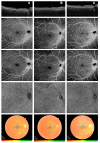Serum microRNA Levels in Diabetes Mellitus
- PMID: 33670401
- PMCID: PMC7918507
- DOI: 10.3390/diagnostics11020284
Serum microRNA Levels in Diabetes Mellitus
Abstract
The aim of our study is to evaluate the serum circulating levels of some miRNA, such as hsa-let-7b-5p, hsa-let-7a-5p, hsa-miR-320b, hsa-miR-23a-3p, hsa-miR-27a-3p, hsa-miR-15a-5p, and hsa-miR-495-3, in diabetic patients without diabetic retinopathy (DR), diabetic patients with DR, and, healthy subjects in order to find reliable and reproducible biomarkers for DR. A total of 45 subjects underwent serum sampling for miRNAs evaluation and a complete ophthalmologic examination, including microperimetry and widefield swept source optical coherence tomography angiography (OCTA). Total circulating RNA was isolated from patients using the miRNeasy Serum/Plasma Kit. Serum miRNA expression levels were significantly different in the three groups. In detail, circulating hsa-miR-15a-5p levels were significantly reduced in both diabetic patients without DR and diabetic patients with DR (p = 0.027). Serum hsa-miR-495-3p was lower in diabetic patients with DR and diabetic patients without DR (p = 0.049). Hsa-miR-23a-3p serum expression levels were significantly lower in diabetic patients with DR and diabetic patients without DR (p = 0.013). Significant associations of miRNAs with anatomical/perfusion parameters and functional parameters were observed in the diabetic groups. We find evidence of damage in progression biomarkers in DR that are evidently early in patients with diabetes without DR. Serum miRNAs levels are considered to have strong potential as a novel biomarker for the early detection of DR in subjects suffering from diabetes and could represent noninvasive target therapies to block the progression of the disease at the early stages.
Keywords: diabetes mellitus; diabetic retinopathy; serum microRNA.
Conflict of interest statement
The authors declare no conflict of interest.
Figures


References
LinkOut - more resources
Full Text Sources
Other Literature Sources

